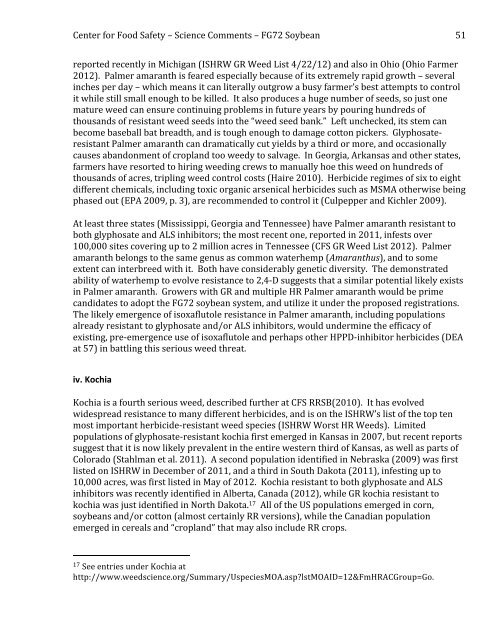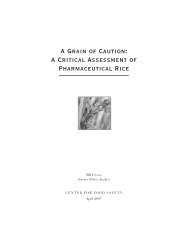a four-fold rise - Center for Food Safety
a four-fold rise - Center for Food Safety
a four-fold rise - Center for Food Safety
You also want an ePaper? Increase the reach of your titles
YUMPU automatically turns print PDFs into web optimized ePapers that Google loves.
<strong>Center</strong> <strong>for</strong> <strong>Food</strong> <strong>Safety</strong> – Science Comments – FG72 Soybean <br />
51 <br />
reported recently in Michigan (ISHRW GR Weed List 4/22/12) and also in Ohio (Ohio Farmer <br />
2012). Palmer amaranth is feared especially because of its extremely rapid growth – several <br />
inches per day – which means it can literally outgrow a busy farmer’s best attempts to control <br />
it while still small enough to be killed. It also produces a huge number of seeds, so just one <br />
mature weed can ensure continuing problems in future years by pouring hundreds of <br />
thousands of resistant weed seeds into the “weed seed bank.” Left unchecked, its stem can <br />
become baseball bat breadth, and is tough enough to damage cotton pickers. Glyphosate-resistant<br />
Palmer amaranth can dramatically cut yields by a third or more, and occasionally <br />
causes abandonment of cropland too weedy to salvage. In Georgia, Arkansas and other states, <br />
farmers have resorted to hiring weeding crews to manually hoe this weed on hundreds of <br />
thousands of acres, tripling weed control costs (Haire 2010). Herbicide regimes of six to eight <br />
different chemicals, including toxic organic arsenical herbicides such as MSMA otherwise being <br />
phased out (EPA 2009, p. 3), are recommended to control it (Culpepper and Kichler 2009). <br />
At least three states (Mississippi, Georgia and Tennessee) have Palmer amaranth resistant to <br />
both glyphosate and ALS inhibitors; the most recent one, reported in 2011, infests over <br />
100,000 sites covering up to 2 million acres in Tennessee (CFS GR Weed List 2012). Palmer <br />
amaranth belongs to the same genus as common waterhemp (Amaranthus), and to some <br />
extent can interbreed with it. Both have considerably genetic diversity. The demonstrated <br />
ability of waterhemp to evolve resistance to 2,4-‐D suggests that a similar potential likely exists <br />
in Palmer amaranth. Growers with GR and multiple HR Palmer amaranth would be prime <br />
candidates to adopt the FG72 soybean system, and utilize it under the proposed registrations. <br />
The likely emergence of isoxaflutole resistance in Palmer amaranth, including populations <br />
already resistant to glyphosate and/or ALS inhibitors, would undermine the efficacy of <br />
existing, pre-‐emergence use of isoxaflutole and perhaps other HPPD-‐inhibitor herbicides (DEA <br />
at 57) in battling this serious weed threat. <br />
iv. Kochia <br />
Kochia is a <strong>four</strong>th serious weed, described further at CFS RRSB(2010). It has evolved <br />
widespread resistance to many different herbicides, and is on the ISHRW’s list of the top ten <br />
most important herbicide-‐resistant weed species (ISHRW Worst HR Weeds). Limited <br />
populations of glyphosate-‐resistant kochia first emerged in Kansas in 2007, but recent reports <br />
suggest that it is now likely prevalent in the entire western third of Kansas, as well as parts of <br />
Colorado (Stahlman et al. 2011). A second population identified in Nebraska (2009) was first <br />
listed on ISHRW in December of 2011, and a third in South Dakota (2011), infesting up to <br />
10,000 acres, was first listed in May of 2012. Kochia resistant to both glyphosate and ALS <br />
inhibitors was recently identified in Alberta, Canada (2012), while GR kochia resistant to <br />
kochia was just identified in North Dakota. 17 All of the US populations emerged in corn, <br />
soybeans and/or cotton (almost certainly RR versions), while the Canadian population <br />
emerged in cereals and “cropland” that may also include RR crops. <br />
17 See entries under Kochia at <br />
http://www.weedscience.org/Summary/UspeciesMOA.asp?lstMOAID=12&FmHRACGroup=Go.







